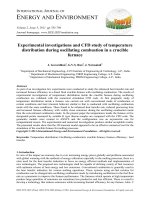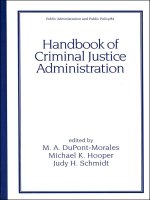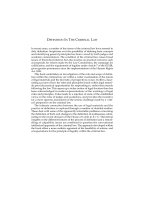CRIMINAL INVESTIGATIONS
Bạn đang xem bản rút gọn của tài liệu. Xem và tải ngay bản đầy đủ của tài liệu tại đây (99.88 KB, 13 trang )
UNIT 3 CRIMINAL INVESTIGATIONS
Before you read the text, discuss with a partner the steps undertaken by the
police in detecting and solving a crime
What is the role of the police as a law-enforcement agency?
What other law-enforcement agencies do you know?
Which departments of the police service deal directly with crime detection and
apprehension of criminals?
What is the act that governs the activity of the police in UK?
What are the arresting procedures in UK?
Who can press or drop charges?
Who can try and sentence a criminal?
Principles of Police Investigations
How closely are the essential principles of investigations related to Human Rights?
What are the consequences of the non-observance of these principles?
What are the causes of abuse in police work?
Exercise 1
Read the following text, complete it by putting in appropriate prepositions and discuss the
issues involved.
The Principles of Police Investigations.
THE CRIME SCENE
Processing a crime scene includes the application (1) … diligent and careful methods by
investigators (2) … recognise, identify, preserve and collect facts and items of evidentiary
value that may assist (3)… reconstructing that which actually occurred. It is (4) … the utmost
importance to the success of any investigation that the investigating officer makes no errors
(5)… the crime scene or (6) … follow-up investigations. Also, the first officer (7)… the scene
must avoid diminishing or destroying potential clues which may eventually lead (8) … the
apprehension of the criminal.
Though the police are expected to investigate crime, a basic function (9) …the police is non-
investigative, that is to keep the peace and protect the people.
Exercise 2
Interviews ands interrogations
In investigations, the interviewing of witnesses, victims and suspects, personal searches,
searches of vehicles and premises, the interception of correspondence and communications,
the police are guided by a series of fundamental principles, as shown below. Complete the
text with the appropriate word from the box
compelled/ presumed/ treated/ subjected / prohibited/ conducted/ exercised/ permitted/exerted
- everyone has the right to security of the person
- everyone has the right to a fair trial
- everyone is to be (1) ____________ innocent until proven guilty in a fair trial
- no one shall be subjected to arbitrary interference with his privacy, family, home
or correspondence
- no one shall be (2) _____________ to unlawful attacks on his honour or reputation
- no pressure, physical or mental, shall be (3)____________ on the suspects,
witnesses or victims in attempting to obtain information
- torture and other inhuman or degrading treatment is absolutely (4) _____________
- victims and witnesses are to be (5)_____________with compassion and
consideration
- confidentiality and care in the handling of sensitive information are to be
(6)____________ at all times
- no one shall be (7)________________ to confess or to testify against himself
- investigatory activities shall be (8)____________ only lawfully and with due
cause
- neither arbitrary, nor unduly intrusive investigatory activities shall be
(9)__________
Reading text Operation ‘Magician’
Discuss these issues with a partner
before reading the text.
How and where can a police officer gather information on a case?
Who does he speak to?
What are the steps an investigating officer takes immediately after discovering a crime?
How important is crime prevention?
What is the situation in Romania?
What can the police do in order to deter crime?
How can the police raise public awareness on every person’s role in detecting, reporting and
deterring crime? What concrete steps can they take?
How cost-effective can crime prevention be compared to crime investigations?
How important are standardised policies, practices and procedures in police work?
Do these limit the liberty of police officers in their work or do they help them?
Read the text Operation Magician
How the Flying Squad foiled the world's biggest ever robbery
Intelligence
In summer 2000 the Metropolitan Police Flying Squad developed intelligence that pointed to
a major armed robbery plot. Its location was unclear, but police knew the identities of some of
the robbers. They also knew the gang was highly organised and would probably be armed.
Over a period of months detectives worked tirelessly to develop the intelligence picture. A
major surveillance operation was launched, using officers from the Met’s Directorate of
Intelligence. Within weeks, police were sure they knew the venue of the robbery – The
Millennium Dome in Greenwich. The exact target within the Dome was not yet clear.
Discuss: how big a risk were the police taking at this point?
Surveillance
On 1 September 2000 three of the suspects, William Cockram, Raymond Betson and Aldo
Ciarocchi were seen at the venue filming with a camcorder and studying the plans of the
Dome.
Over the coming weeks the surveillance continued, and further members of the gang were
identified and some of the men were spotted testing a speedboat in a harbour in Kent.
Detectives thought the gang might use the boat as a getaway. The robbery was getting close.
Discuss: What practical steps should the police already have been taking?
The JCB Mechanical Digger
By early October police inquiries had identified another venue linked to the robbery – The
Old Coal Yard in Whitehart Road, Plumstead. The detectives observed gang members with a
yellow mechanical digger, registration L245 AJU. The digger had been reported stolen some
months earlier and would clearly have some role to play in the robbery.
Discuss: JCBs ( yellow construction/digging vehicles) had been used before in a new
version of the “smash and grab” raid known as “ram raids” What precautions should the
police have taken?
The River
Police could not be sure when or indeed exactly how the robbery would take place On a
number of days in October the gang looked as if they were about to commit the offence. On
three separate days they towed a speedboat to Greenwich and placed it in the river opposite
the Dome. Other activity on those days tended to indicate that the robbery was close – but
strangely it didn’t materialise. Detectives were sure that there was more to this than merely a
loss of nerve on the robbers’ part. They analysed the times and days of the aborted attempts
and found that they had something in common – the tide. On each of the days when the
robbery was aborted the tide was at its highest possible level. This was vital to the robbers’
escape, since the boat could only be launched on the north side of the Thames when the water
was high. Through studying the patterns of the tide, police were able to predict the optimum
times for the robbery to take place. One of these days was 7 November 2001
Discuss: Speedboat .. river.. possible mooring and launching locations.. tides.. a very
obvious deduction and conclusion by the police ?
Activity 1 The Day of the Robbery
Match the two parts of the sentences to complete the text.
1) At 3 a.m. on 7 November 2001, approximately 200 officers involved in Operation
Magician...
2) They were prepared for a tactical operation which had been months...
3) Public safety was the prime consideration and officers had plans....
4) Amongst those present were 40 specialist firearms officers....
5) Others were sent into the Dome in disguise....
6) Surveillance officers disguised as Dome employees...
7) A further 60 armed Flying Squad officers were stationed around the Thames....
Officers also moved to a number of observation points between the Old Coal Yard in
Plumstead and the Dome.
8) The Dome’s CCTV room was turned into a police control room...
A. gathered at the Dome for a dawn briefing
B. dressed as cleaners they concealed their guns in black plastic bags and rubbish bins.
C. to ensure that the robbers could be arrested quickly and safely at any given stage
during the incident.
D. from where Det. Supt. Jon Shatford ran the whole operation.
E. and 20 on the river itself.
F. who would be hidden behind a secret wall within the Dome and in other places.
G. in planning and providing contingencies for many different outcomes.
H. also patrolled the area.
1 2 3 4 5 6 7 8
A
Discuss: If you had been a gang member would YOU have been keeping surveillance on
the Dome?
Timetable of events on the morning of 7 November 2001
7:26
A white Transit van registration N770 AHE was seen towing the red and
white speedboat along West Ferry Rd on the Isle of Dogs. The passenger was
later identified as Kevin Meredith.
8:11
White Ford Transit van, registration number C673 COR, drove into the Old
Coal Yard in Plumstead. The JCB was parked there.
8:39
A red and white speedboat was seen travelling east along the Thames towards
the Dome. The driver, later identified as Kevin Meredith, then crossed the
river into Bow Creek where he tied the boat up and waited.
8:43
The JCB and van drove out of the Yard towards Plumstead. The
JCB driver – later identified as Betson- was wearing a fluorescent
waistcoat. The JCB traveled towards Greenwich, turning right into Anchor
and Hope Lane. At this point the white van was lost. The driver was not
identified and the vehicle has never been recovered.
9:07
The JCB travelled along Bugsby Way towards the Dome. It turned left
beneath the A102 Blackwall Tunnel Approach and parked up out of sight.
Police believe that this is where Ciarocchi, Cockram and Robert Adams got
into the JCB alongside Betson. The gang had modified the cabin to fit four
people.
The JCB turned left into Ordnance Crescent towards the Dome. It stopped
in Drawdock Road, just short of the Dome’s perimeter fence.
9:33
The JCB crashed through a gap in the fence, flattening a metal bollard as it
went. It headed towards Gate 4 of the Dome.
9:35
The JCB rammed open the double locked gates at Gate 4 and moved into
the grounds of the Dome.
9:36
The speedboat crossed the Thames toward the Dome from Bow Creek. It
got into position at Millennium Pier where it waited for the robbers.









